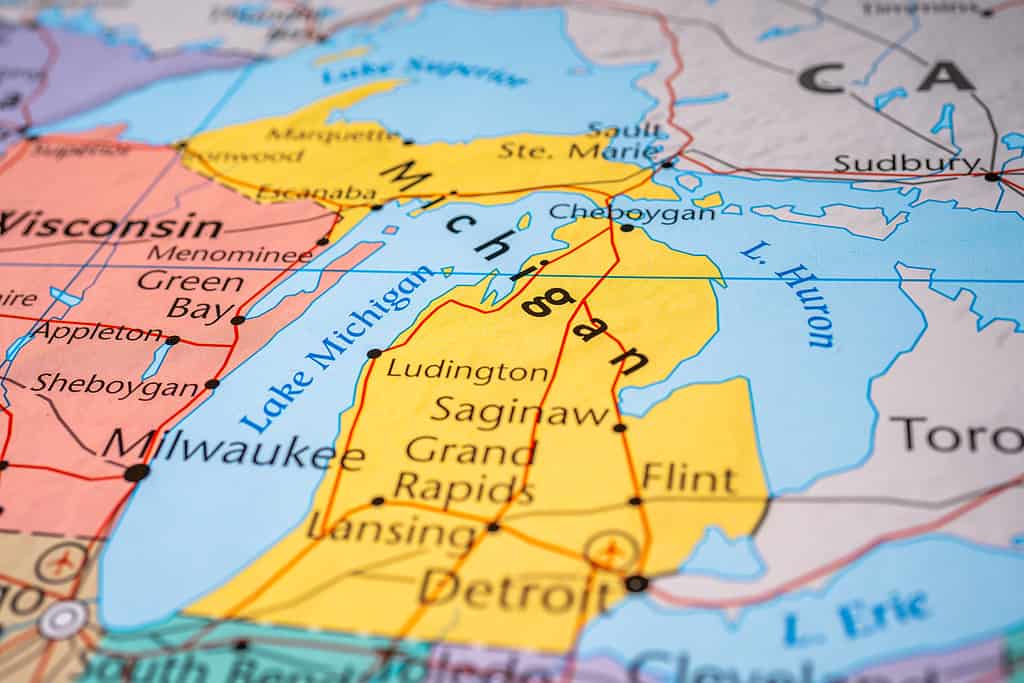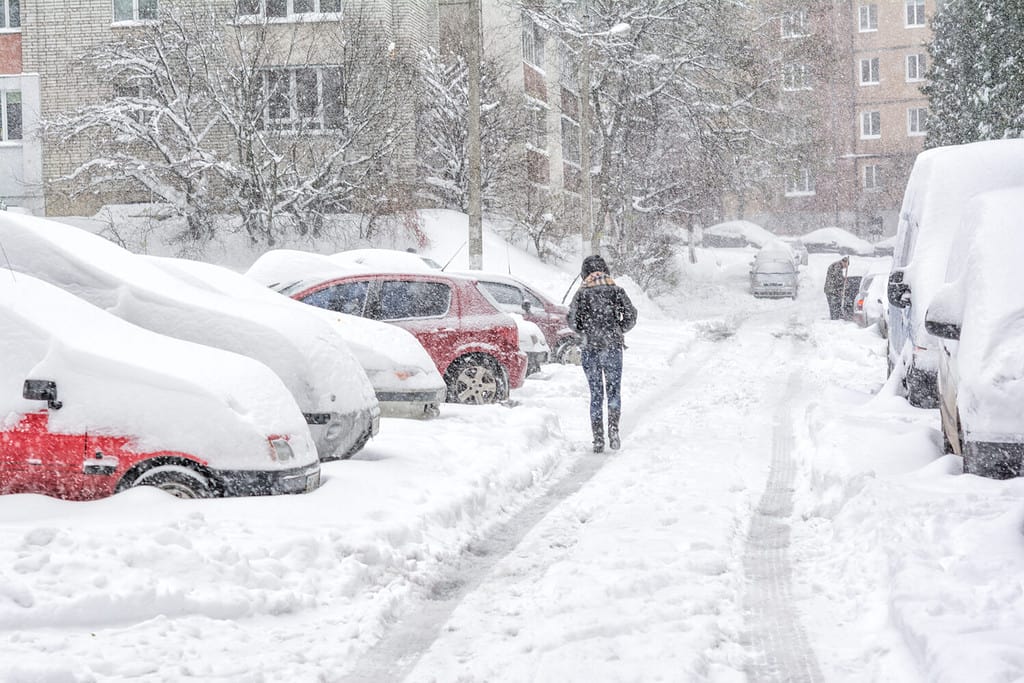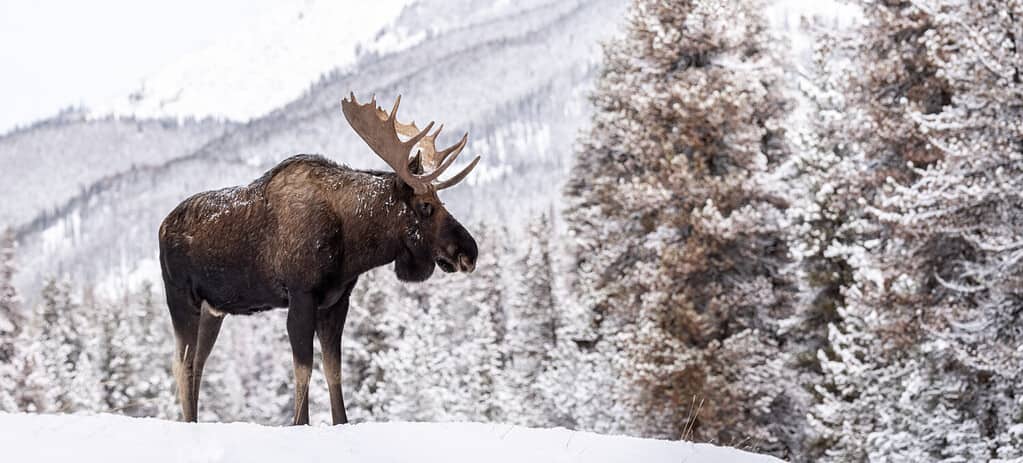Areas bordering the Great Lakes of the United States boast some of the most intense wintry storms on the planet. The state of Michigan is tucked among four of the five Great Lakes. Thanks to its unique geography, it’s no wonder that the biggest November snowstorm in Michigan history dumped an absurd amount of snow.
Snow in Michigan
Michigan is no stranger to snowy winters. Ranked the sixth snowiest state in the United States, it sees on average more than 70 inches of snow every year. The national average for the country is 34 inches.
The Great Lakes State, as Michigan is often called, is home to two of the top 10 snowiest cities in the United States. According to Farmer’s Almanac, Sault Ste. Marie, MI, is the snowiest city with a population above 10,000 people in the country. The winning city receives an average snowfall of 119.3 inches per year. That’s just shy of 10 feet every year!
Coming in at number eight, Muskegon, MI, gets close to 80 inches of snow annually. The state of Michigan, however, has many snowy cities. Grand Rapids (74.6 inches), Flint (49.9 inches), and Detroit (43 inches) all have notable annual snow totals.
The Biggest November Snowstorm in Michigan History

Certain areas in Michigan see copious amounts of snow due to freezing winds from the Great Lakes that bring lake-effect snow.
©Ralf Broskvar/Shutterstock.com
November 2014 is a historic month in Michigan’s climate history. A series of storms and lake-effect snows combined to bring up to 60 inches of snow to some areas of the Great Lakes State, according to the National Oceanic and Atmospheric Administration’s (NOAA) National Climatic Data Center.
Weather.com reported that two rounds of lake-effect snow and a three-day snowstorm “clobbered many of the lake-effect snowbelts, particularly western New York, northern Lower Michigan, and the state’s Upper Peninsula.”
Gaylord, in northern Lower Michigan, was buried under 60.9 inches of snow by the end of November 2014. According to the National Weather Service, November 18-20 broke Gaylord’s record for the snowiest three-day period with 29.6 inches. The biggest November snowstorm in Michigan history blasted Gaylord particularly hard. In a normal year, the area will see 18 inches in November.
Sault St. Marie, the country’s snowiest city, received an astonishing 65.4 inches in November 2014. That month broke the old record of 46.8 inches from November 1989. Sault St. Marie is located on the Upper Peninsula.
Snow in Marquette, also on Michigan’s Upper Peninsula, reached 53 inches that November. The community averages 17.6 inches of snow on a typical Thanksgiving month.
Grand Rapids, in western Michigan, broke the previous November record from 1895 by more than an inch. The city’s November 2014 total was 29.3 inches of snow. More than two feet of snow fell in only five days, beginning November 16, with almost 10 inches falling just on November 18.
At the height of the late-fall/early-winter blast, some locations across the Grand Rapids metro region saw a foot or more of snow in a day. That total is almost double the average for the entire month of November in Grand Rapids, which usually picks up 6.8 inches of snow.
What Caused All that Snow?
The Lake Effect
Lake-effect snow can create some of the most dramatic and efficient snowstorms on the planet. One of the most powerful lake-effect snow events on record left close to 12 feet of snow in just 10 days on the Tug Hill Plateau in New York in February 2007.
Role of Temperature
This unique process of snow creation known as the lake effect results from the interaction between cold air as it passes over warmer lake water. That interaction generates snow that falls on localized regions downwind from the lake. Lake-effect snow occurs most often in the late fall and early winter months.
Snow squalls off lakes are a product of the temperature difference between cold air and warmer lake water. The greater the difference, the greater the amount of snow the squall will produce. Since lake water has not had time to cool down by the beginning of the winter, lake-effect snow is more likely during that time.
As cold, dry air travels over areas of warmer water, the cold air near the surface warms and begins to take on moisture from the lake. Once the water molecules rise upwards, they condense and eventually form clouds. The water molecules in these clouds freeze in the cold air and are deposited downwind on the opposite side of the lake from where the wind originated.
Fetch
When it comes to absurd amounts of snow, fetch is not a fun game to play with your dog. Fetch is the distance that wind travels over open water. When wind spends more time traveling over the water over a longer distance, it accumulates more precipitation. A longer fetch means more snow.
Stiff winds captain these heavily saturated snow clouds over lakes and onto land where they organize into bands. Multiple but narrow bands of snow cover a larger area with a modest blanket of snow from a short fetch. A long fetch, on the other hand, creates single, thick bands of snow that drop absurd amounts of snow. The biggest November snowstorm in Michigan history had a long fetch.
Michigan’s Geography

Michigan’s Upper Peninsula and western Michigan are usually the hardest hit by lake-effect snow.
©Alexander Lukatskiy/Shutterstock.com
Michigan’s geography makes it prime real estate for lake-effect snow. Hemmed in by four of the largest lakes on the planet, areas of the Mitten State are covered in an average of up to 170 inches of snow each year.
A very large snowbelt covers much of the Upper Peninsula of Michigan, near the cities of Houghton, Marquette, and Munsing. These areas are blanketed in 250-300 inches of snow on average each season. While certain areas can see 14 feet of snow a season, other areas of Michigan experience more moderate amounts. This is due to the nature of lake-effect snow systems.
Areas of Michigan on the leeward side of the Great Lakes are more prone to these blockbuster snow events thanks to prevailing winds from the northwest. These snow squalls usually hit the Upper Peninsula and western Michigan the hardest. For comparison, while Grand Rapids saw record snowfall during the biggest November snowstorm in Michigan’s history with 31 inches, further east, the Detroit metro area was only dusted with four inches that month.
Origins of Michigan’s Biggest November Snowstorm
Local governments called the November 13-21, 2014, North American storm “Knife.” Residents who lived through the ordeal nicknamed that month “Snowvember.” It was associated with an extreme cold wave that chilled most of Canada and the contiguous United States.
A perfect storm of events coalesced to dump the most snow ever recorded onto areas of Michigan in November. On November 8, 2014, a fragment of the polar vortex descended from the Arctic region to lower Canada and the Eastern United States. These freezing temperatures reached all the way down into Jacksonville, Florida, where the thermometer registered 24 degrees Fahrenheit, breaking a record set in 1873.
While these freezing temperatures gripped the country, a winter storm emerged from Canada to the north of the Midwest. Around the same time, another storm triggered a strong lake-effect band. On November 16, 2014, Lake Erie had a water temperature of 48 degrees Fahrenheit. By the evening of November 17, the air crossing over the lake was -14 degrees Fahrenheit.
November 2014 Across the Country

Snow in November 2014 covered the largest amount of land in the contiguous United States on record for that month.
©Tainar/Shutterstock.com
Snowvember
Aptly nicknamed Snowvember, the November 2014 contiguous U.S. snow cover extent was the largest on record. More than 50 percent of the lower 48 states had snow on the ground in mid-November. The cold front caused temperatures to drop more than 70 degrees Fahrenheit in a 24-hour period in parts of Montana.
The November snow cover for the contiguous United States was 400,000 square miles above the 1981-2010 average. According to Rutgers Global Snow Lab, that was the largest November snow cover extent in the 49-year satellite record.
New York
The biggest November snowstorm in Michigan’s history created problems for areas well beyond its borders. Buffalo, NY, was another area that suffered the brunt of the snow system.
The epic November 2014 lake-effect snow event was one of the most significant weather events in Buffalo’s snowy history. The same snowbelt that makes the Upper Peninsula and western Michigan susceptible to copious lake-effect snow also includes Buffalo and the surrounding region.
Located on the eastern shore of Lake Erie, Buffalo was walloped with two rounds of lake-effect snow in November 2014. Southern Cheektowaga, a suburb of Buffalo, took the record for the maximum snowfall total in 48 hours. More than 65 inches of snow buried the town in only two days.
Then-New York Gov. Andrew Cuomo declared a state of emergency for several counties on November 18. The snow forced all major highways around Buffalo to close, stranding thousands of motorists. The sheer weight of the accumulated snow collapsed more than 300 roofs.
Deaths During the Storm
Deaths related to the storm hit Buffalo the hardest. The five to seven feet of snow that fell in the area killed at least 26 people. Heart attacks from overexertion when trying to remove snow, however, caused the majority of deaths.
Financial Costs of the Snow
According to the Insurance Information Institute, winter storms in 2014 caused up to $2.5 billion in insurable losses. That made 2014 the fourth costliest year of blizzards on record.
In New York, Gov. Andrew Cuomo reported the blockbuster storm that clobbered Buffalo in November 2014 cost more than $46 million, far surpassing the threshold for federal emergency aid.
How Do Animals Fare in Extreme Cold?

Certain species living in Michigan thrive during its signature frigid winters.
©Harry Collins Photography/Shutterstock.com
Hibernation
Contrary to popular belief, very few animals in Michigan actually hibernate. Woodchucks, skunks, chipmunks, 13-lined ground squirrels, and some types of bats are the only animals in the state that truly hibernate.
Reptiles/Amphibians
Michigan’s reptile and amphibian residents can only survive the state’s severe winter cold by burying themselves in mud or burrowing deep underground. Some species, like the wood frog, can actually freeze solid. While most insects die before winter arrives, they leave their eggs in winter-proof containers that ensure the next generation will live on once temperatures warm.
Snow Lovers
Many species that call the Great Lakes State home are called chionophiles, or snow lovers. Small mammals like voles and shrews create their own ecosystem under the cover of snow. Moose thrive in cold weather. Their long legs and warm coats make them well-equipped for dealing with Michigan winters.
Deer
Michigan’s deer population, on the other hand, didn’t fare as well as some of the state’s other species of snow lovers. In November 2014, Michigan’s Upper Peninsula deer population was struggling.
While the total number of deer in the area was uncounted, Michigan’s Department of Natural Resources (DNR) estimated that the Upper Peninsula lost tens of thousands of deer that winter combined with the previous year’s winter. The department reported that the area lost an entire age cohort because of the back-to-back harsh winters.
By December 2014, the DNR announced it was making supplemental deer-feeding permits available a month earlier than in the past. Officials also asked timber companies to leave treetops on the ground as food and shelter for foraging deer.
The photo featured at the top of this post is © iStock.com/Big Joe
Thank you for reading! Have some feedback for us? Contact the AZ Animals editorial team.







